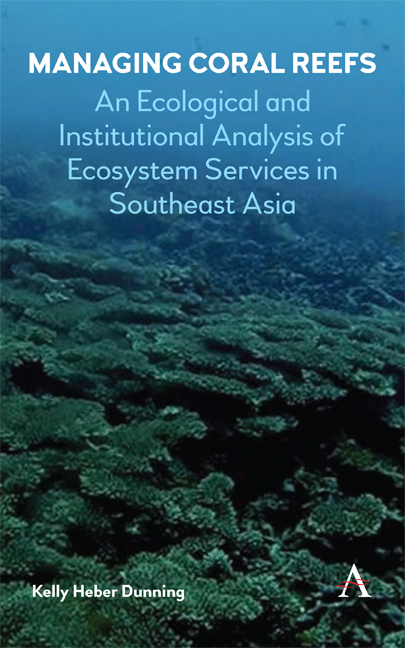 Managing Coral Reefs
Managing Coral Reefs Book contents
- Frontmatter
- Contents
- List of Figures
- List of Tables
- Acknowledgments
- List of Abbreviations
- 1 Introduction
- 2 Theory, Practice and Policy Context of Coral Reef Management
- 3 Governing Natural Resources in Indonesia and Malaysia
- 4 Case Study Sites and the Coral Triangle
- 5 Integrated Management of Marine Protected Areas
- 6 Legitimate Marine Protected Areas
- 7 Adaptive Capacity of Marine Protected Areas
- 8 Policy Recommendations for Marine Protected Area Management in Developing Countries
- Appendix A Research Design
- Appendix B Data and Methods
- Appendix C Coral Cover Results
- References
- Index
2 - Theory, Practice and Policy Context of Coral Reef Management
Published online by Cambridge University Press: 16 August 2018
- Frontmatter
- Contents
- List of Figures
- List of Tables
- Acknowledgments
- List of Abbreviations
- 1 Introduction
- 2 Theory, Practice and Policy Context of Coral Reef Management
- 3 Governing Natural Resources in Indonesia and Malaysia
- 4 Case Study Sites and the Coral Triangle
- 5 Integrated Management of Marine Protected Areas
- 6 Legitimate Marine Protected Areas
- 7 Adaptive Capacity of Marine Protected Areas
- 8 Policy Recommendations for Marine Protected Area Management in Developing Countries
- Appendix A Research Design
- Appendix B Data and Methods
- Appendix C Coral Cover Results
- References
- Index
Summary
Multilateral Frameworks for Conservation in Indonesia and Malaysia
In both Indonesia and Malaysia, the turning point for ecosystem governance came in the wake of the 1992 Convention on Biological Diversity (CBD). The CBD is a global framework aimed at preventing further loss of biodiversity while encouraging sustainable use and equitable sharing of genetic resources. The CBD suggested goals that signatory states should take to prevent biodiversity loss. The Aichi Targets included numerical protected area goals for member nations, such as Target 11, to set aside 17 percent of terrestrial areas and 10 percent of coastal and marine areas, especially biodiversity hotspots, by 2020. Additionally, Target 14 instructs signatory states to ensure that critical ecosystem services that impact livelihoods of the poor are restored or protected (Aichi Biodiversity Targets 2016).
The CBD tasks its member states with handling implementation of the treaty, and estimates that 40 million Indonesians depend on biodiverse ecosystems for subsistence (CBD 2016a). The NationalDevelopment Planning Agency of Indonesia authored the Biodiversity Action Plan for Indonesia (BAPI) in 1994. It focused on strengthening institutions to prevent biodiversity loss using both scientific and local knowledge while ensuring a balance between ecosystem use and livelihood. A key element of the desired institutional change involved less of a focus on national parks and greater attention to devolving resource management (CBD 2016a). The key to implementing BAPI was to incorporate biodiversity conservation plans into the work of local government planning agencies. This set the stage for devolved management in the late 1990s.
Malaysia's policy for biodiversity protection can be found in its 1988 National Policy on Biological Diversity with 87 action plans for implementing the CBD. The policy focuses on improving centralized marine protected area (MPA) institutional frameworks, resolving confusion over federal-state and interagency cooperation and increasing the number of scientific experts working on conservation. In Malaysia, implementation of the CBD is spearheaded by the Ministry of Natural Resources and Environment, which is also the home of Malaysian marine parks (CBD 2016b).
- Type
- Chapter
- Information
- Managing Coral ReefsAn Ecological and Institutional Analysis of Ecosystem Services in Southeast Asia, pp. 11 - 24Publisher: Anthem PressPrint publication year: 2018


